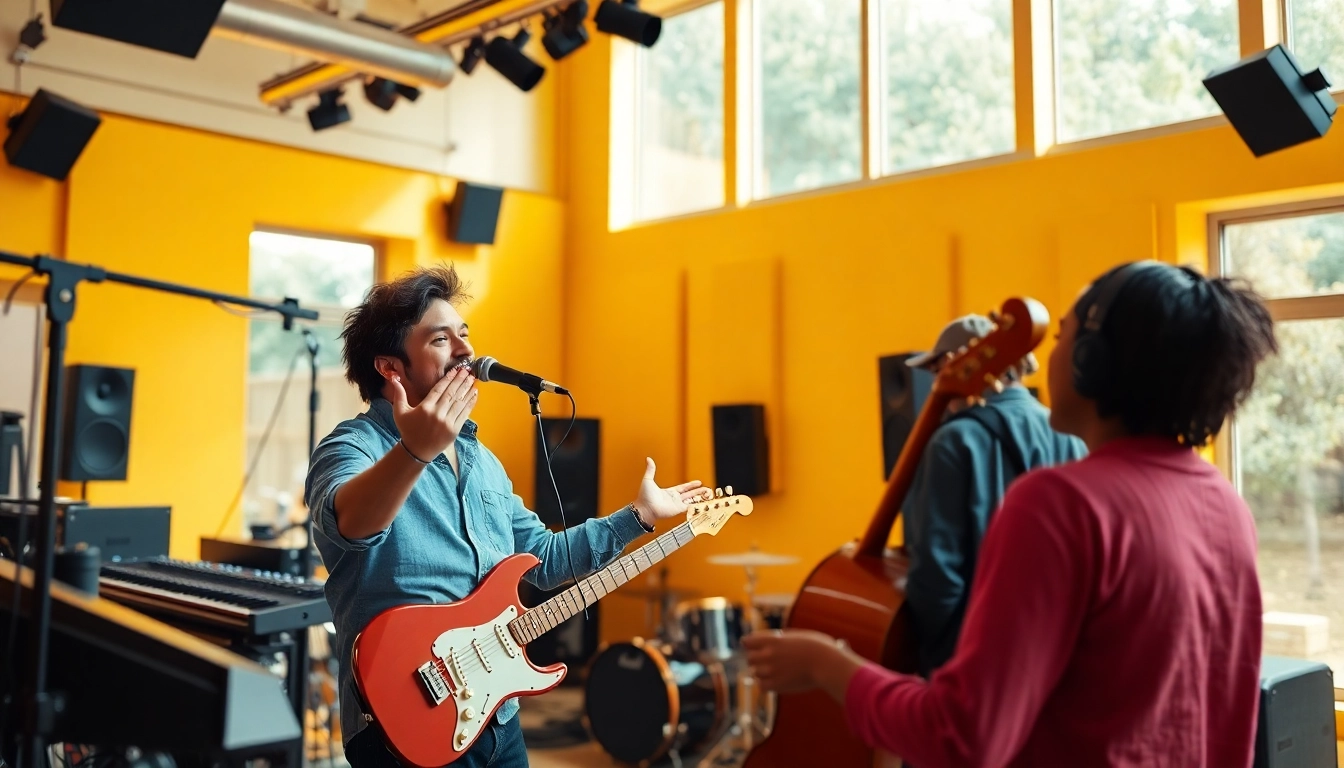Understanding the Basics of Music Pitching
What is Music Pitching?
Music pitching is the art of presenting songs to industry professionals, with the intent to secure placements in various media outlets such as playlists, radio stations, and blogs. Essentially, pitching is akin to marketing—it’s about conveying the value and potential of a track to gain interest and, ideally, support from curators or influencers. This process is crucial for artists looking to expand their reach and connect with audiences on platforms where exposure can significantly affect their career trajectory.
The Importance of Music Pitching for Artists
For aspiring artists and seasoned musicians alike, effective music pitching can be a game-changer. In today’s highly competitive music industry, merely creating great music is often not enough. Artists need to strategically promote their work to get it heard amid a flood of new releases. Strong pitching skills can lead to key opportunities, including:
- Increased streams and visibility on digital platforms
- Opportunities for collaboration with established artists
- Requests for live performances or interviews
- Expanded fanbase and community engagement
By learning to effectively pitch their music, artists can drive traffic to their profiles and build a solid foundation for their careers. For more information on how to refine your strategy for music pitching, stay tuned for actionable insights.
Common Myths About Music Pitching
Many artists harbor misconceptions that can hinder their pitching efforts. Some common myths include:
- Myth 1: Only established artists can get attention.
- Myth 2: Short and direct pitches are always better.
- Myth 3: Once you’ve pitched, the work is done.
Dispel these myths by understanding that even emerging artists can capture attention when they present their authentic voice. Pitches need to be carefully crafted because a well-detailed pitch can convey passion and commitment, making it easier for curators to help you reach audiences.
Crafting Your Music Pitch
Essential Elements of a Successful Pitch
Crafting an effective pitch is crucial. Here are key elements to include:
- Personalization: Address the curator by name and reference their previous work or playlists. This shows you’ve done your research.
- Storytelling: Share the inspiration or story behind your song. This emotional connection can resonate with curators.
- Links to Your Music: Include direct links to the song or streaming platform, along with any relevant press coverage or social proof.
- Call to Action: Encourage the curator to listen and provide options—such as a link to your social media for instant sharing or feedback.
By integrating these components, artists can enhance the appeal of their pitches and improve their chances of success.
Examples of Effective Music Pitches
Examining successful pitching examples can shed light on what works. Here’s a hypothetical example:
Subject: “Exclusive Preview: [Song Title] – [Artist Name]”
Body:
Hi [Curator’s Name],
I hope this message finds you well! I’m [Artist Name], a [genre] singer-songwriter from [Location]. I’m a big fan of your playlist [Playlist Name], and I think my new project, “[Song Title],” which is set to release on [Date], could resonate with your audience. This song was inspired by [brief backstory that establishes connection].
Here are links to the track and my social pages:
- [Link to the track]
- [Link to Instagram/Facebook/etc.]
I would love for you to check it out and hopefully feature it on [Playlist Name]. Thank you for considering, and I’m happy to answer any questions!
Best,
[Your Name]
[Contact Information]
This example showcases personalization, storytelling, and clear links, increasing the chances of a positive response.
Tailoring Your Pitch for Different Audiences
Every target audience is unique, necessitating customized pitches. Consider these points:
- Curators: When pitching to playlist curators, be explicit about how your song fits their theme and existing tracks.
- Blogs: Bloggers often appreciate a more detailed narrative—include your journey, notable achievements, and how your work can engage their readers.
- Radio Stations: Use a succinct and professional tone, focusing on airplay potential and listener demographics.
By customizing your pitches, you can increase their relevance and effectiveness.
Best Practices for Pitching to Playlists
How to Research Playlists Effectively
Understanding the playlists you’re targeting is fundamental. Start with these steps:
- Search on Streaming Platforms: Use Spotify, Apple Music, and others to discover playlists that suit your genre.
- Analyze the Curator’s Previous Selections: Note the types of tracks they prefer, as this insight can inform your pitch.
- Utilize Playlist Submission Platforms: Tools like SubmitHub and Daily Playlists can help you connect with various curators efficiently.
Thorough research sets the stage for a targeted and relevant approach.
Do’s and Don’ts of Playlist Pitching
As you refine your approach, consider these do’s and don’ts:
- Do: Keep your pitches concise and relevant.
- Do: Follow submission guidelines precisely.
- Don’t: Spam curators with music; one to two well-researched submissions is more effective.
- Don’t: Ignore any responses—even if it’s a rejection, maintain professionalism for future opportunities.
Your attitude and respect for curators’ time can significantly affect your music’s visibility and your reputation in the industry.
Leveraging Social Media for Pitching
Social media is a powerful tool for not just promoting your music but also for establishing connections that can aid pitching:
- Engagement: Engage with potential curators or influencers through comments, likes, or shares. Building rapport is vital.
- Showcase Your Journey: Share behind-the-scenes content about your music-making process to make your pitch more relatable.
- Collaborate: Collaborate with other artists or influencers, cross-promoting each other’s work can expand reach organically.
When used strategically, social media can augment your pitching strategy by providing a platform to build relationships and showcase your work at the same time.
Following Up on Your Music Pitch
When and How to Follow Up
Following up is an essential part of the pitching process. Timing and tone matter greatly. Consider these guidelines:
- Wait for a Response: Give curators a week or two to respond, considering their busy schedules.
- Keep it Friendly: A simple follow-up message should reiterate your interest and ask if they had a chance to listen.
- Be Respectful: If they declined or don’t respond, respect their decision and avoid aggressive follow-ups.
Respecting curators’ timelines may open doors for future opportunities, as artists who show professionalism tend to be remembered favorably.
Responding to Feedback from Curators
Curators may provide feedback, whether positive or negative. It’s crucial to respond appropriately:
- Positive Feedback: Thank them for their support and ask for opportunities to collaborate in the future.
- Constructive Criticism: Acknowledge their input and express interest in improving based on their suggestions.
- Negative Responses: Thank them for considering your work, and consider asking for any additional suggestions they may have for future pitches.
Responses can create lasting impressions, building relationships that may benefit your music career down the line.
Adapting Your Pitching Strategy
The music industry is dynamic, so adapting your pitching strategies is vital for staying relevant. Regularly evaluate your success by:
- Reviewing Responses: Analyze the feedback—what resonates or doesn’t with curators.
- Staying Updated: Keep abreast of trends in music and how they affect curators’ needs and expectations.
- Testing New Channels: Explore different platforms and media for showcasing your music; stay flexible.
Being adaptable not only improves your chances of success but also demonstrates your commitment to growing as an artist.
Measuring the Success of Your Music Pitching Efforts
Key Performance Indicators for Music Pitches
To gauge the effectiveness of your music pitching, track relevant metrics such as:
- Streaming Numbers: Monitor how many streams your song receives after pitching.
- Playlist Adds: Track how often your track is added to playlists compared to previous releases.
- Social Media Engagement: Look at how your social media interactions change post-pitch.
Using these indicators can inform not only your pitching strategy but also broader marketing decisions.
Using Metrics to Refine Your Pitch Strategy
Metrics collected can help refine your approach:
- Analyze Sources of Engagement: Determine which platforms yield better engagement and target them more.
- Evaluate Pitch Formats: If certain types of pitches lead to better responses, consider focusing on those styles.
- Test Timing: Experiment with submitting pitches at different times and observe which periods result in better responses.
Being data-driven in your approach will nurture a more effective pitch strategy and ultimately benefit your music career.
Case Studies of Successful Music Pitching
Examining successful case studies can illustrate effective strategies in action. For instance, many artists gained substantial popularity through systematic pitching:
Case Study 1: Independent Artist ‘X’
This artist utilized a campaign targeting niche playlists, leveraging data analytics to identify trending sounds compatible with their music style. By personalizing pitches and respecting curators’ time, they increased their streaming by 150% within three months.
Case Study 2: Band ‘Y’
This band focused on storytelling in their pitches, detailing their journey and ambitions. After a targeted pitch to influential blogs, their single received features across major music outlets, expanding their reach and fanbase significantly.
These examples illustrate the potential for success when artists embrace thoughtful, informed pitching strategies.



